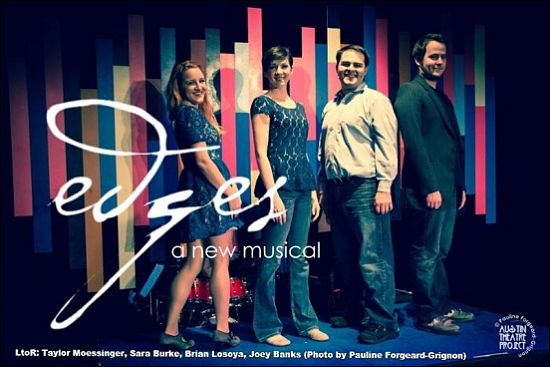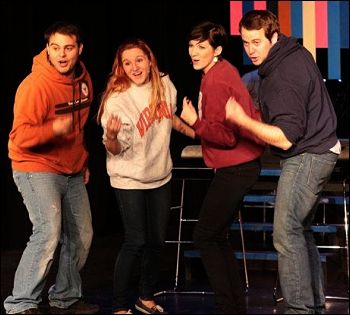Review: Edges, a song cycle by Austin Theatre Project
by David Glen Robinson
The Austin Theatre Project (ATP) production of Edges by Benj Pasek and Justin Paul gave Austin beautiful music and performances guaranteed to please audiences. Problems with the production and Pasek’s and Paul’s relatively new and somewhat uneven show shouldn't certainly not scare away ticket buyers, certainly not the heart-and-soul musical theatre fanatics who live for it.
The program notes were about the music and nothing but the music. They explained the show as a song cycle in which all the songs stand by themselves, tell their own stories and are bound only loosely to an overall theme. The ATP production played the impressive music with three pieces; keyboards played by musical director David Blackburn, bass played by Kyle Welch and a drum set played by long term Austin percussionist Terri Lord. She put the Austin in the show, definitely. ATP assembled an exquisite corps of singers: Joey Banks, Sara Burke, Brian Losoya and Taylor Moessinger
The venerable Dougherty Arts Center theatre has surprisingly good acoustics, and while the singers wore pin-mikes, they would have had no difficulty reaching the back seats without them. Singing miked makes it easier on the voice to sing through a long, complex show, but it also may tempt the performer to go for power and not make choices for more nuanced and other-shaped tonalities (pear and other shapes). At various times, all the singers succumbed to the lure of power, but at other times they made the richer choices. Notably, Brian Losoya and Taylor Moessinger made and succeeded at intricate choices to create harmonies in the ensemble. The results were simply a pleasure to hear and by themselves were worth the ticket price. Credit goes to the singers and musical director Blackburn.

In such a complex show, a few bobbles and glitches are to be expected. These were predictably more frequent in Act Two, but none of these missteps in the music or performances was really worth noting. One problem in the design fields, however, was persistently annoying. There was a dark zone down stage center where much focal singing took place as well as the curtain speech by musical director Blackburn. The darkness (“black hole”) was not fixed through the show, and five feet to either side, performers danced and sang shiningly. I looked upward at the lighting grid a few times and saw what seemed to be sufficient instruments to light the stage. Audience members should not have to stand ready to roll up their sleeves, climb ladders, and refocus instruments in order to see the show. The error was fundamental. Someone tell the responsible technician that it is lighting design, not darking design.
My issues on the negative side of the ledger have more to do with Edges the musical show, not ATP’s production of it. This cycle of stand-alone songs loosely themed around people in their 20s is built of papier mache denatured urban middle class America. For anyone older than their 20s (most of the audience), well, who cares who your next boyfriend or girlfriend will be? And who cares what you want to do with your last boyfriend? Actually, I do care, because that particular song was inappropriate. The Sandy Hook mass murder changed things, and librettists and producers need to change along with them.
Still, musical theatre inhabits a house next door to the house of pop music, where absolute fluff makes fortunes, sticks in the minds of the populace and enters the culture. The point here is that song lyrics don’t always have to be deep, but they do have to resonate somehow to become worthy and memorable.

Out of the musical mass of beer drinking, Facebookin’ and growing up normally there emerged a few of these more resonant bright spots, which naturally shone more brightly by the contrast. The song immediately after the cute I-want-to-see-him-dead song was One Reason. It was a mature consideration of suicide sung by Joey Banks, and it was sensitive and devastating at the same time.
In a show about young people finding their way in life, Part of a Painting was the song about finally finding that path. The epiphany came in the Greek Islands, making singer Brian Losoya seem to be part of a painting. In the well-polished and well-turned fashion of show songwriting, at song’s end he invites his loved one to enter that painting with him. Losoya deftly took us through the emotions and turnings of the complex song. This was a demonstration piece. Brian Losoya is a young artist en route to artistic mastery, and we all should attend his future shows to enjoy his singing, performing and growth in musical theatre.
Austin Theatre Project’s production of Edges by Pasek and Paul overcame many obstacles to fulfill its commitment to excellence, for which the audience is grateful and satisfied. The Dougherty Arts Center proved itself a fitting venue for meeting the complexities of musical theatre production.
Edges was full of leading-edge show music, but it proved itself ultimately a somewhat schizophrenic work by a composer and librettist with disparate skill levels. Most of the lyrics were just this side of oatmeal. One of the song’s lyrics was offensive, and a few songs may prove memorable.
Taylor Moessinger was notable for her performance throughout the show. She betrayed no fatigue, and in her styling and costuming looked like a porcelain doll come to life; but she was anything but robotic. Her movement, vocal and emotional ranges were impressive, and she made it all look easy. We want to hear her in many more singing roles.
Hits as of 2015 03 01: 1253
Edges, a song cycle
by Benj Pasek and Justin Paul
Austin Theatre Project
